Based on costs, effectiveness, and operational efficiency a landfill operator should choose an ADC based on their unique site-specific circumstances.
By J.D. Mohr
Federal regulations require that landfill waste be covered at the end of every workday. The landfill is required to apply 6 inches of soil, or an alternative daily cover material (ADC) that meets EPA guidelines. Some common ADCs consist of non- reusable geosynthetic film, tarps, slurry/foam spray products, and indigenous materials like auto shredder fluff.
Over the life of the landfill, using an ADC instead of soil can result in a 10 to 20 percent savings of valuable airspace. In certain cases, ADC can be a more cost-efficient means of cover. Other times, it may come at an additional cost, but solve some type of operational issue such as odor or soil deficiency. Cost, performance, and site conditions should all be factored in when evaluating ADCs.
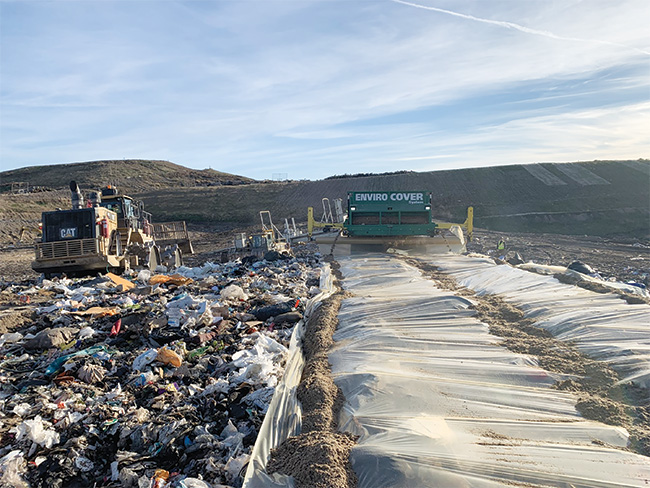
Photos courtesy of EPI Enviro Cover.
EPA ADC Guidelines
Let’s look at what regulators consider to be the most important “boxes to check”.
Disease Vector Control
This refers to animals or insects that are known to carry diseases.
Fire Protection
Your daily cover should be nonflammable and minimize potential fire hazards by limiting the amount of atmospheric oxygen into the waste. ADC should impede the spread of fire in the landfill as well.
Odor Control
Decaying organic waste in MSWLFs produce foul odors that can escape into the atmosphere from the uncovered surface of the waste. ADCs should control odors by preventing them from escaping into the atmosphere.
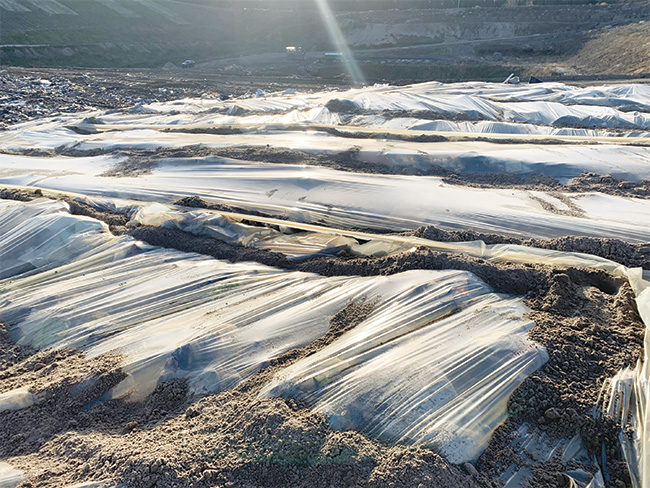
Blowing Litter Control
Waste disposed of at MSWLFs includes items such as paper, plastic sheets, and rags that may be picked up and carried away by the wind. An effective ADC will securely hold waste in place where it was initially deposited on the working face.
Scavenging
Animals such as birds, dogs, deer, and pigs can be enticed by waste disposed of at MSWLFs. Large groups of animals congregating near the MSWLFs can be a nuisance or hazard to nearby residents and businesses. A common concern is birds populating near the landfill creating a hazard to air traffic, particularly when they develop flocks. ADCs should impede the animals’ ability to access the waste.
Additional Considerations
Regulations in 40 CFR Subpart 258.21 specify that an ADC should control/minimize fugitive dust, act as a moisture barrier to prevent precipitation from infiltrating the waste, and improve general site aesthetics.
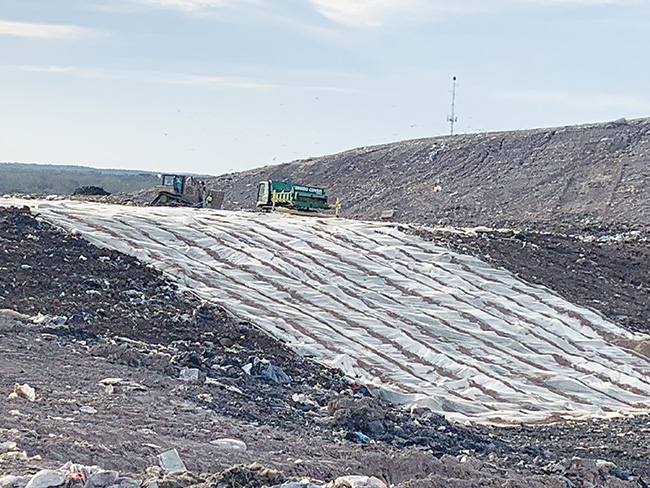
Dust Control
When analyzing an ADC, consider its effectiveness to mitigate fugitive dust from lightweight materials such as ash. In dry climates with high winds this can be especially critical to keep dust from drifting offsite onto neighboring properties.
Moisture Barrier
Moisture infiltrating waste typically generates leachate that can be costly and time consuming to deal with. When selecting an ADC, make this a strong consideration as the permeability of the material can greatly determine its overall performance. A porous material will easily allow precipitation to enter the working face and, ultimately, generate leachate. This is also important when considering spray on and foam type ADCs as you may inadvertently exacerbate odor/leachate volumes. If an ADC requires mixing with water, determine the gallons necessary. Do some analysis so you understand the impact a water-based ADC will have on leachate generation once it makes its way through the waste. What may seem like a harmless solution may be costing you big in leachate expenses.
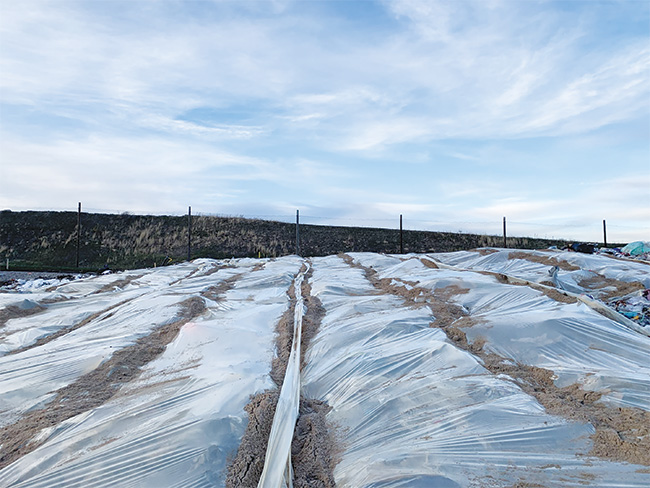
Aesthetics
The ADC should provide a uniform color and surface “pleasing to the eye”. In some rare situations, the working face can actually be visible to the public. An aesthetically pleasing cover will draw less attention. “Flagging” is also another “red flag” regulators look for when doing inspections. This is sometimes an issue when spreading soil or placing temporary tarps. As the dozers track over the waste debris, it clings to the tracks and is tracked off the waste.
ADC … Under the Microscope
An often-overlooked consideration of ADC are “specific technical factors”. Factors such as tensile strength, gas/liquid permeability, and flammability should all be considered. If you are experiencing odor issues, you probably want to avoid a very permeable type of cover. If you already are having excessive leachate expenses, you may want to avoid any cover that introduces additional liquid into the landfill. Give the actual physical composition of the ADC a good vetting to understand how effective it will be in meeting the EPA guidelines for compliance.
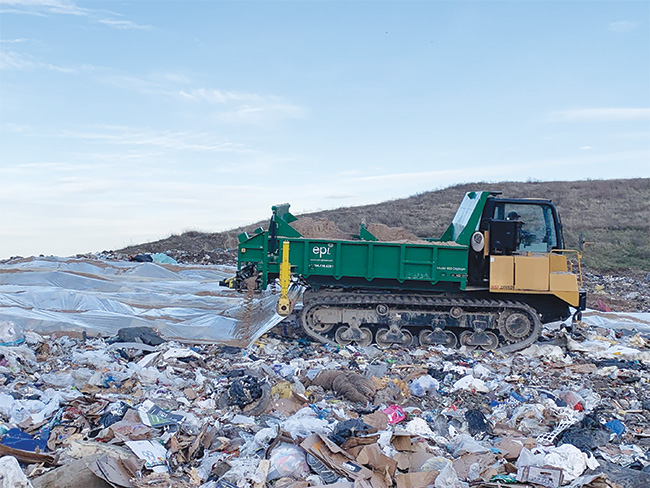
Operational Considerations of ADCs
Unless tackling a specific problem like odor, ADC analysis usually defaults to cost first. Consider ease of deployment and durability in adverse climate conditions. If you operate in a region with heavy rainfall, you may want to avoid ADCs that easily wash off. A torrential rain event will quickly put you out of compliance. In addition, ADCs that are water based will need to be kept warm in below freezing climates to be viable.
Look at labor costs of ADCs vs. indigenous materials and decide if the benefits of the ADC outweigh the extra labor for deployment. Also, determine if applying the ADC will make life easier, or potentially more difficult for your crew in the field. A hands-on trial for 30 days or more is an excellent way to evaluate the good, bad, and ugly of a new potential ADC method.
Cover Your Backside
We discussed the major compliance items as prioritized by the EPA. Based on costs, effectiveness, and operational efficiency, a landfill operator should choose an ADC based on their unique site-specific circumstances. When implementing any type of new operational solution, a short-term trial for “hands on” experience is invaluable. Take photos, establish metrics, and document everything during your trial so you do not inadvertently find yourself “out of compliance”. | WA
J.D. Mohr is Business Development Executive for EPI Enviro Cover. He has more than 16 years in the waste industry as a business owner and waste industry consultant. J.D. can be reached at (317) 316-2922, e-mail [email protected], or visit www.envirocoversystem.com
